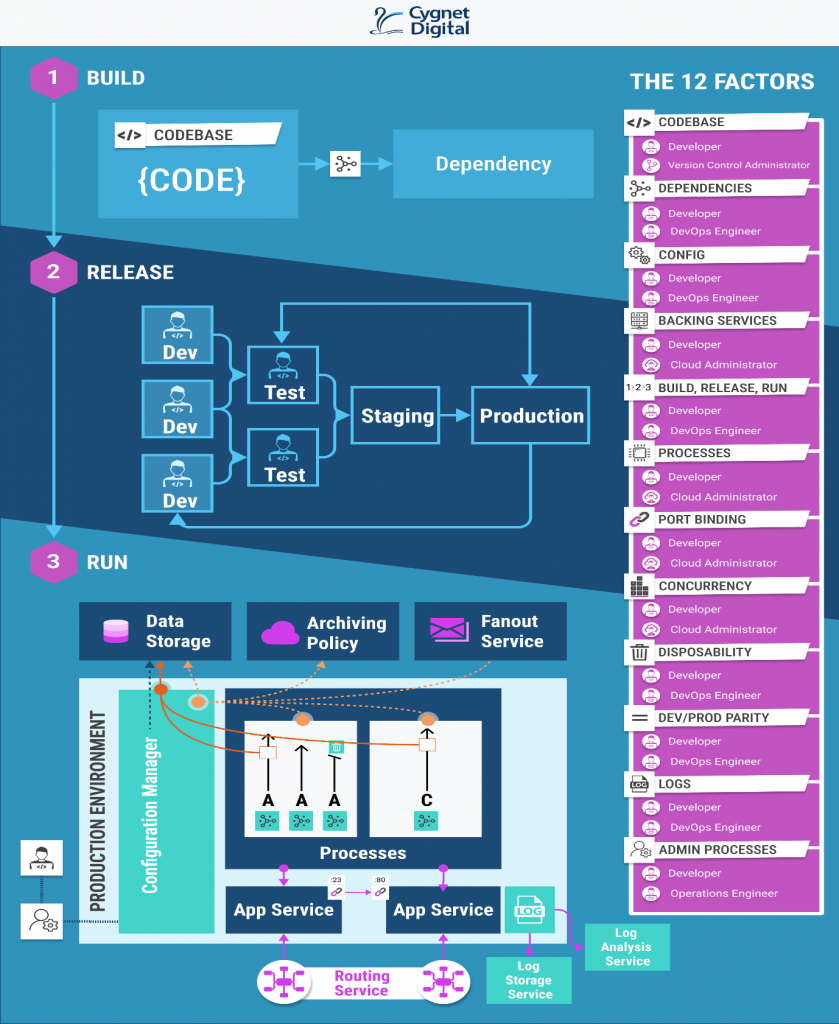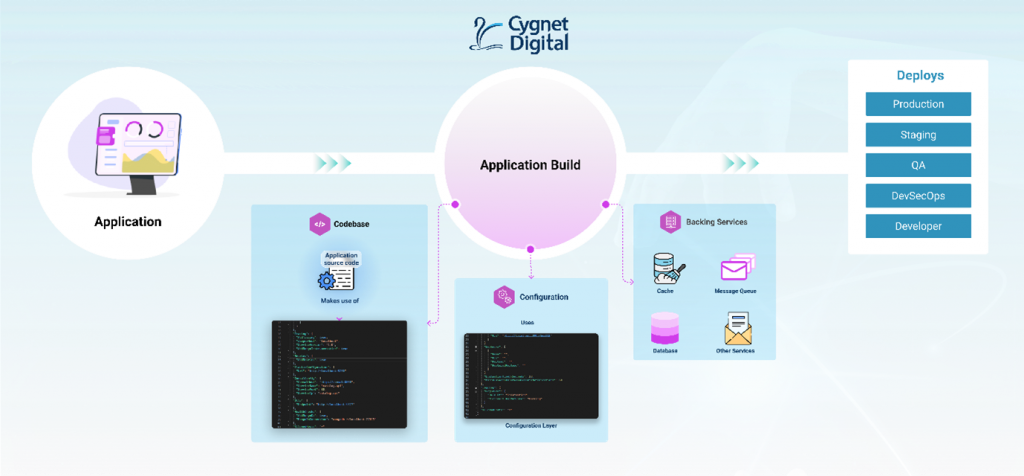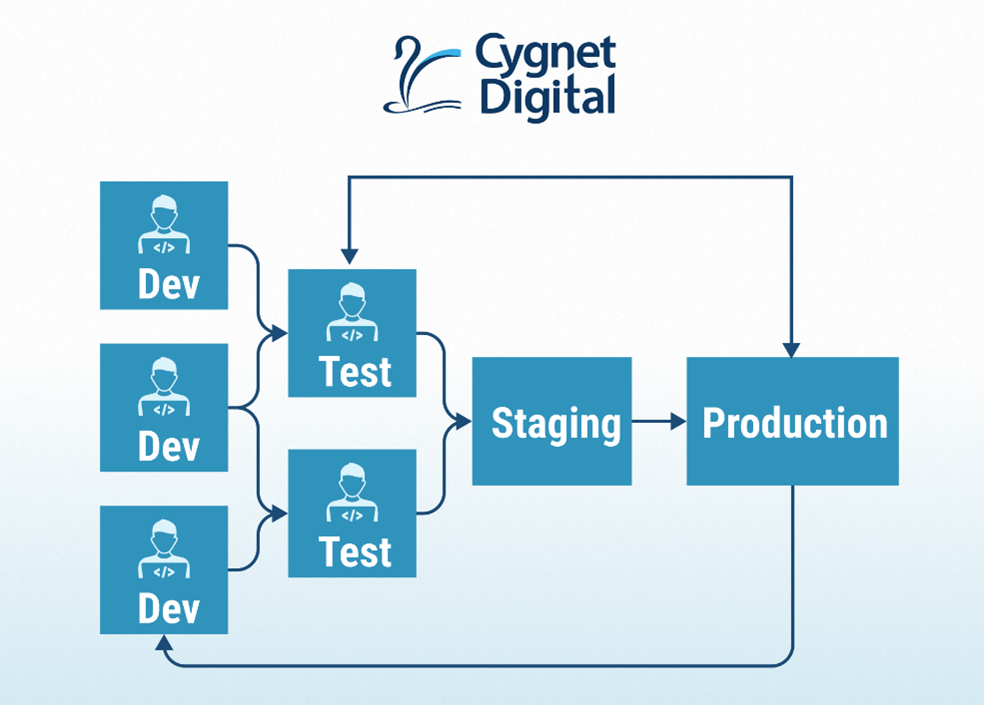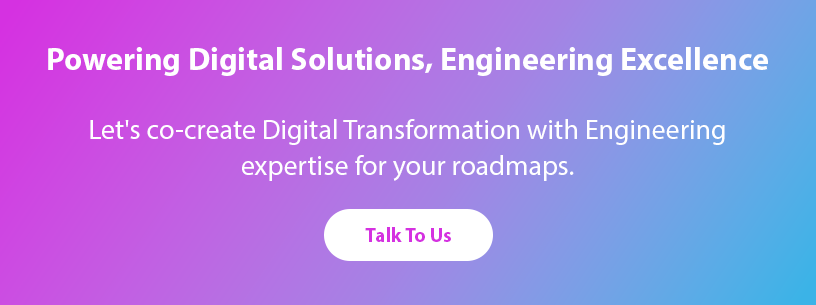Planning the application architecture is essential to software development best practices as it creates robust, scalable, secure, and maintainable software that meets business needs and keeps pace with evolving technology. The application architecture guidelines provide a roadmap for developers, ensuring that applications are simple, well-structured, efficient, and built to last. It also limits the redundancy and technology sprawl to reduce costs. The 12-Factor App Principles serve as a valuable framework for achieving these goals. Let’s know more details about the benefits of these principles.
Benefits of using 12-factor App Principles
- Scalability: The principles encourage building applications that can easily scale horizontally. This allows the application to handle increased loads by adding more instances, making it suitable for cloud-based environments.
- Flexibility: By following the 12 Factor App principles, applications become more adaptable to different environments, making it easier to move them between development, staging, and production environments without modification.
- Maintainability: The principles promote clean code practices, separating configuration from code and minimizing dependencies. This makes the application easier to maintain and update over time.
- Portability: Applications developed following these principles are more portable across different platforms and cloud providers, reducing vendor lock-in and allowing for greater flexibility in choosing infrastructure.
- Consistency: The 12-factor app principles establish a consistent set of guidelines that help developers uniformly structure their applications, making it easier for teams to collaborate and understand each other’s code.
- Resilience: By adhering to these principles, developers ensure that applications are designed to handle failure gracefully. Components can be easily replaced without affecting the entire application.
- Visibility and Debuggability: The principles promote logging as a first-class citizen, making debugging issues easier and monitoring the application’s behavior.
- Developer Onboarding: New team members can quickly understand and start contributing to an application that follows the 12-factor principles because of the standardization and clear separation of concerns.
- Security: Separation of configuration from code helps avoid hardcoding sensitive information, improving security practices.
- Statelessness: The principles encourage building stateless applications, which can be more easily scaled and maintained. A state can be managed externally, which simplifies scaling and deployment.
- Continuous Deployment: The principles align well with the continuous deployment philosophy, allowing frequent releases and easier rollbacks.
- Evolvability: The principles foster an environment where applications can evolve and adapt to changing requirements and business needs.
The 12-Factor App Principles
The 12-factor methodology is a set of principles and best practices that provide valuable guidance for designing modern, scalable, and maintainable software applications. It was introduced by Adam Wiggins and represented a culmination of years of experience developing web application architecture. These principles address common challenges in building and deploying applications in a cloud-native environment. By assigning roles to each of the 12-factor methodology factors, we can explore their significance in creating resilient and scalable applications. Let us delve into each factor and understand how it contributes to modern software development, fostering robustness and scalability in application design and deployment.

Codebase: It is essential to track one codebase in revision control or version control, such as Git. It emphasizes the importance of having a single source of truth for the application’s code. It allows for consistency, collaboration and easy deployment across environments, even when deployed multiple times. For example, multiple developers can work on different features simultaneously and merge their changes seamlessly.
With a revision control system, developers can track changes, review historical commits, and revert to previous versions, providing a solid foundation for managing the application’s lifecycle. A single codebase enables continuous integration and deployment (CI/CD) pipelines. Automated testing, building, and deploying processes rely on the codebase to deliver consistent and reliable updates to the application. Using a single codebase also allows for atomic deploys, where an entire application is deployed at once.
Role of Developers and Version Control Administrator
- Developers: They work collaboratively to maintain a single codebase in a version control system like Git. It promotes a clear understanding of the application’s architecture, reduces the risk of code inconsistencies, and allows for streamlined version control and deployment processes.
- Version Control Administrator: They manage the version control system, set up branching strategies, and ensure proper code organization. It enhances reliability, security, and proper functioning by managing access, integrations, backups, and performance.
Dependencies: One must very clearly declare and isolate dependencies. Use a package manager like npm for JavaScript or pip for Python to manage dependencies and ensure reproducibility. With dependency management in app design, developers can easily install and update dependencies without conflicts leading to better maintainability, portability, and security. Proper handling of dependencies ensures that an application can seamlessly interact with external services, be deployed to different environments without modifications, and stay up to date with the latest security patches and improvements.
Role of Developers and DevOps Engineer
- Developers: They explicitly declare dependencies in a manifest file (e.g., package.json or requirements.txt) and manage them using a package manager. By actively managing dependencies, developers ensure their software applications are stable, secure, and maintainable. Proper handling of dependencies enables developers to focus on building application features and functionality without being burdened by intricate management of external libraries and services.
- DevOps Engineer: They configure the build process to resolve and install dependencies during deployment. DevOps engineers contribute to software applications’ overall reliability, security, and performance. Their focus on automation, consistency, and monitoring ensures that the application’s dependencies are handled efficiently throughout the development lifecycle, leading to smoother deployments and reduced risk of operational issues.
Configuration: Configuration refers to any data that varies between different environments or deployments of an application. This includes environment-specific settings, credentials, connection strings, and other parameters influencing the application’s behaviour. For configuration management in applications, one muststore configuration in the environment. Instead of hardcoding configuration values, utilize environment variables or external configuration files. For example, an application may retrieve the database connection details from environment variables, making configuring different database connections for development, staging, and production environments easy.
Properly managing configuration is essential for building portable and maintainable applications. It allows applications to be more adaptable and easily deployable across different environments. By externalizing configuration and avoiding hardcoding, developers can build resilient, secure, and portable applications, making it easier to maintain and scale them effectively.
Role of Developers and DevOps Engineer
- Developers: They use environment variables or external configuration files to store configuration values separately from the codebase. Developers contribute to the application’s overall reliability, security, and scalability by actively managing configuration. Effective configuration management allows the application to adapt to different environments easily and enables seamless updates and maintenance without requiring code changes.
- DevOps Engineer: They set up environment variables or config files in different environments and ensure the application correctly reads them. DevOps engineers ensure that applications are consistently and securely configured across different environments. They contribute to the application’s reliability, scalability, and security by implementing robust configuration management practices and automation.
Backing services: Backing services are the external resources or services an application depends on to perform its core functionalities. These services are typically not part of the application’s codebase but are essential for the application to operate correctly. These services can include databases, message queues, caching systems, email services, third-party APIs, etc. should be treated as attached resources. Access these backing services for applications via a well-defined interface (e.g., a URL or connection string). This approach allows for easy swapping of services and simplifies configuration management.
Separating the application code from backing services and managing them as external resources allows for better control and adaptability, making it easier to deploy and manage applications in different environments and take advantage of cloud-based or managed services for critical functionality.
Role of Developers and Cloud Administrators
- Developers: They define interfaces for interacting with backing services and integrate them into the application. By effectively managing backing services, developers ensure that their applications can leverage external resources efficiently, remain resilient to failures, and provide a seamless experience to users. Collaboration with operations teams is crucial in handling critical aspects like disaster recovery, scaling, and monitoring, enabling a robust and performant application with reliable backing services.
- Cloud Administrator: They manage the provisioning and configuration of backing services, ensuring they are accessible to the application. It helps ensure the reliability, scalability, and security of cloud-based applications. Their expertise in cloud technologies and best practices enables efficient utilization of resources and the successful integration of critical services into the application’s architecture.

Build, Release, Run: One should precisely separate the build, release, and run stages in app development as three distinct stages of an application’s lifecycle, each with its specific considerations. The build process compiles code and package dependencies. The release process combines the build with the environment-specific configuration. The run process executes the application in the target environment. Tools like Jenkins or GitLab CI/CD pipelines can automate these stages to achieve continuous integration and deployment.
These three stages adhere to the principles of consistency, reproducibility, and automation. By externalizing configuration, using version control, and ensuring uniformity across different environments, developers can create applications that are easily built, executed, and deployed in a reliable and scalable manner.
Role of Developers and DevOps Engineer
- Developers: They define build scripts and automation processes to compile the code, package dependencies, and create deployable artifacts. Developers are instrumental in ensuring the application lifecycle’s build, release, and run stages are seamless and efficient. By writing high-quality code, automating the build and deployment processes, and maintaining continuous improvement, they help create robust and reliable applications.
- DevOps Engineer: They orchestrate the build, release, and run stages using CI/CD pipelines, configuring the appropriate environment-specific settings during release. They bridge the gap between development and operations, ensuring the application development process is streamlined and deployments are automated, reliable, and scalable. This helps organizations deliver high-quality software more quickly and reliably. Their automation, infrastructure management, and collaboration expertise ensures that applications are deployed and operated efficiently.
Processes: Processes refer to the individual instances of the application running in the execution environment. One should run the application as one or more stateless processes. This means each process does not store its own persistent state and can be started or stopped independently from other processes.It creates applications that are highly scalable, portable, and resilient.
Stateless applications can be easily scaled horizontally to handle increased traffic and allow rapid deployments. For example, a web application deployed on multiple instances behind a load balancer can handle more concurrent requests.
Role of Developers and Cloud Administrators
- Developers: They design the stateless application, ensuring it can be scaled horizontally by running multiple instances. They focus on writing code that embraces concurrency, operates independently, and can be easily deployed and scaled, resulting in more robust and resilient applications. They focus on writing code that embraces concurrency, operates independently, and can be easily deployed and scaled, resulting in more robust and resilient applications. Thus, they create scalable, maintainable, and well-suited applications for modern cloud and container-based environments.
- Cloud Administrator: They set up the infrastructure to accommodate running multiple application instances and load-balancing requests across them. They are responsible for handling various aspects of provisioning, monitoring, scaling, and optimizing processes. This ensures the smooth operation and performance of applications in cloud-based environments.
Port Binding: It refers to the act of exporting services provided by an application to the external world by binding the application to a specific network port. It is one of the key aspects of making an application’s services available to other processes or external systems.
One must self-contain a web server and bind to a port dynamically assigned by the execution environment. Port binding enables communication between the application and other services, clients, or users. It allows the application to be portable and efficiently run in different environments and export services via port binding.
Role of Developers and Cloud Administrators
- Developers: They design the application to bind to a dynamically assigned port provided by the execution environment. It enables the application to expose its services to the external world securely and efficiently. Properly implemented port binding contributes to the application’s scalability, availability, and interoperability with other components in the overall system architecture.
- Cloud Administrator: They configure the network infrastructure to route traffic to the appropriate port on the running application instances and handle various aspects related to port binding to make services provided by applications accessible to other processes, services, or external users. This ensures the proper configuration and accessibility of applications in cloud-based environments.
Concurrency: It refers to the application’s ability to handle multiple tasks or requests simultaneously and efficiently. Concurrency is crucial for improving the application’s performance, responsiveness, and resource utilization. One must scale out by adding more instances of the application via the process model and use the resources to design applications that embrace concurrency and scaling in app architecture. For example, a microservices architecture can handle an increased workload by deploying multiple service instances and load-balancing requests between them.
By incorporating concurrency in the application design, the application becomes scalable and responsive and performs highly while handling multiple tasks and requests simultaneously. The application’s ability to process concurrent operations efficiently is essential for achieving optimal performance and making the most of modern computing environments with multi-core processors and distributed architectures.
Role of Developers and Cloud Administrators
- Developers: They build the application to handle concurrent requests efficiently, utilizing threading, asynchronous programming, or distributed computing techniques. Their decisions and coding practices significantly influence how well the application can handle multiple tasks and requests simultaneously.
- Cloud Administrator: They set up auto-scaling rules and provision additional instances of the application based on demand. They ensure the infrastructure scales to meet concurrency demands, optimizing resource allocation and supporting high-performance, resilient, and responsive applications.
Disposability: One should boost the app’s robustness by ensuring a quick startup and elegant shutdown. Applications should be able to start and stop quickly. For example, containerization technologies like Docker enable rapid deployment and scalable application design by efficiently spinning up and shutting down containers.
The disposability principle emphasizes the importance of treating application processes as disposable entities which can be started or stopped at any time without adverse effects on the overall system. This principle promotes resilience, fast deployment, and efficient resource utilization. Disposability ensures the application’s lifecycle is flexible, enabling a more robust and responsive system overall.
Role of Developers and DevOps Engineer
- Developers: They optimize the application for fast startup and graceful shutdown, handling any necessary cleanup or state persistence. This enables the application to start up quickly, shut down gracefully, and handle failures with resilience. These efforts contribute to a more robust and responsive application and support modern cloud-native practices.
- DevOps Engineer: They configure the deployment process to ensure the application starts and stops smoothly without impacting user experience. Their efforts promote a highly scalable, available, and resilient application ecosystem where applications start up quickly, shut down gracefully, and adapt efficiently to changing demands.
Dev/prod parity: This principle advocates the idea that there should be consistency between development, staging, and production environments. Using similar configurations, backing services, and deployment mechanisms across environments can reduce environment parity for applications. This mitigates potential issues caused by environment discrepancies when deploying code from development to production. The goal is to reduce the risk of errors, improve reliability, and streamline the deployment process.
Consistency across environments reduces the risk of production failures and increases confidence in deploying new features and updates to the application. Ultimately, dev/prod parity contributes to a more reliable, scalable, and maintainable application ecosystem.
Role of Developers and DevOps Engineer
- Developers: They strive for consistency between development, staging, and production environments, including configurations, services, and deployment mechanisms. Their efforts ensure that code behaves consistently from development through to production, reducing the chances of errors and issues during deployment and improving the overall reliability and scalability of the application.
- DevOps Engineer: They ensure that the infrastructure and deployment processes closely resemble the production environment, facilitating smooth transitions and minimizing issues. Their efforts are essential for fostering collaboration between development and operations teams, ensuring that applications can be efficiently deployed and managed in different development lifecycle stages.

Logs: It refers to the practice of recording application events, error messages, and other relevant information during its operation. Logging and monitoring of apps are essential for understanding the application’s behavior, monitoring its performance, and troubleshooting issues. Proper log management ensures that critical information is accessible, enabling the development and operations teams to maintain high application reliability and availability.
One should consider logs as event streams and write them to stdout or stderr. The log aggregation may be centralized using tools like ELK Stack (Elasticsearch, Logstash, and Kibana), Splunk, or Fluentd for easy troubleshooting, monitoring, and analysis.
Role of Developers and DevOps Engineer
- Developers: They implement logging within the application code, writing log events to stdout or stderr for easy capture. They ensure that logs are well-implemented and well-structured to provide valuable insights into the application’s behavior and performance, facilitate debugging, troubleshooting, monitoring, and auditing, and enable a more reliable and maintainable application ecosystem.
- DevOps Engineer: They set up log aggregation and analysis tools to collect and analyze logs from the running application instances, aiding in troubleshooting and monitoring. Their efforts contribute to building a reliable and resilient application ecosystem where logs are valuable for maintaining and improving application health and performance.
Admin Processes: One needs to run administrative/management tasks as one-off processes, separate from the regular application processes, to ensure isolation and maintain operational integrity. For instance, running database migrations or performing backups are typically executed as separate scripts or commands.
Admin processes are essential for performing tasks such as database migrations, system configuration, data backups, and other administrative activities necessary during the application’s lifecycle. The separation of admin processes from the main application codebase and their explicit invocation help maintain a clear distinction between regular operations and administrative activities, leading to a more manageable and robust application ecosystem.
Role of Developers and Operations Engineer
- Developers: They implement administrative tasks as separate scripts or commands, allowing for isolation from the main application processes. This ensures that administrative tasks are handled effectively and securely. Properly managed admin processes help maintain a clear separation between regular application operations and one-off administrative activities, contributing to a more reliable and maintainable application ecosystem.
- Operations Engineer: They execute, monitor, and maintain administrative tasks, such as running database migrations or performing backups, following established procedures. This helps maintain a stable and secure application ecosystem. Their infrastructure, security, and system administration expertise ensure that administrative tasks are executed reliably and efficiently.
By following the 12-factor app principles, developers can build scalable, portable, and resilient applications. This approach aligns well with cloud-native architectures, microservices, and containerization, enabling teams to adopt modern development practices and leverage the power of cloud computing technologies.
At Cygnet, our experts have a robust digital foundation of application architecture guidelines and software development best practices. We have helped our clients reduce their operational costs, manual efforts, and paperwork with our applications. You can learn more about our digital, application, and product engineering capabilities and use cases and contact us to benefit from our expertise.











